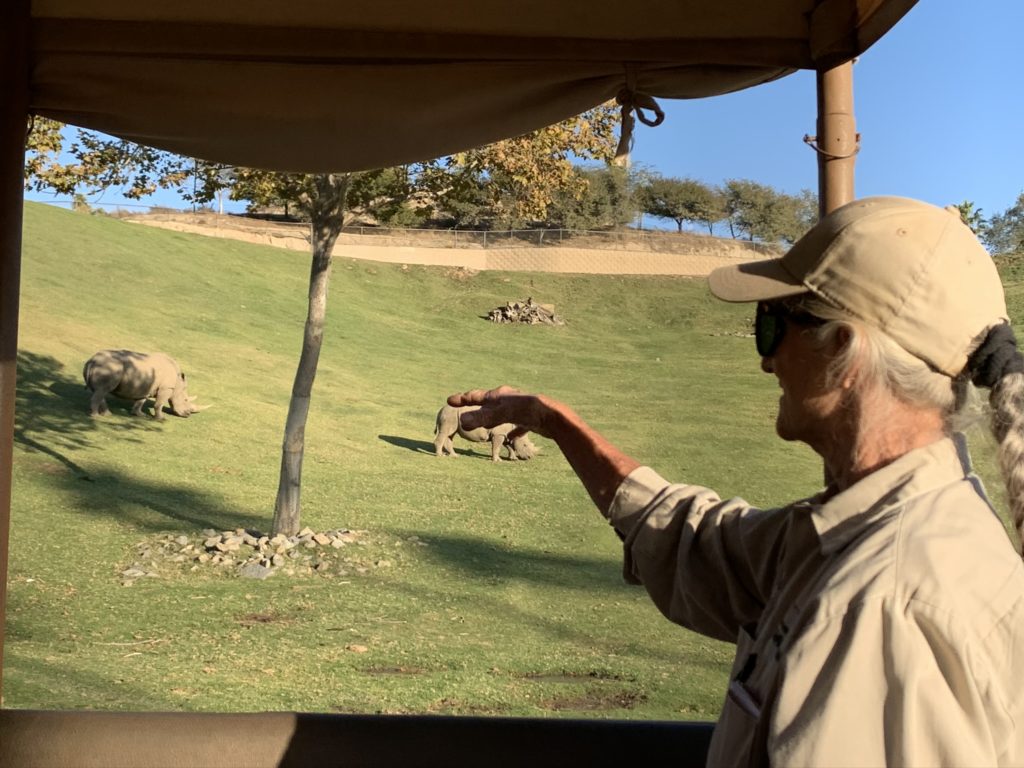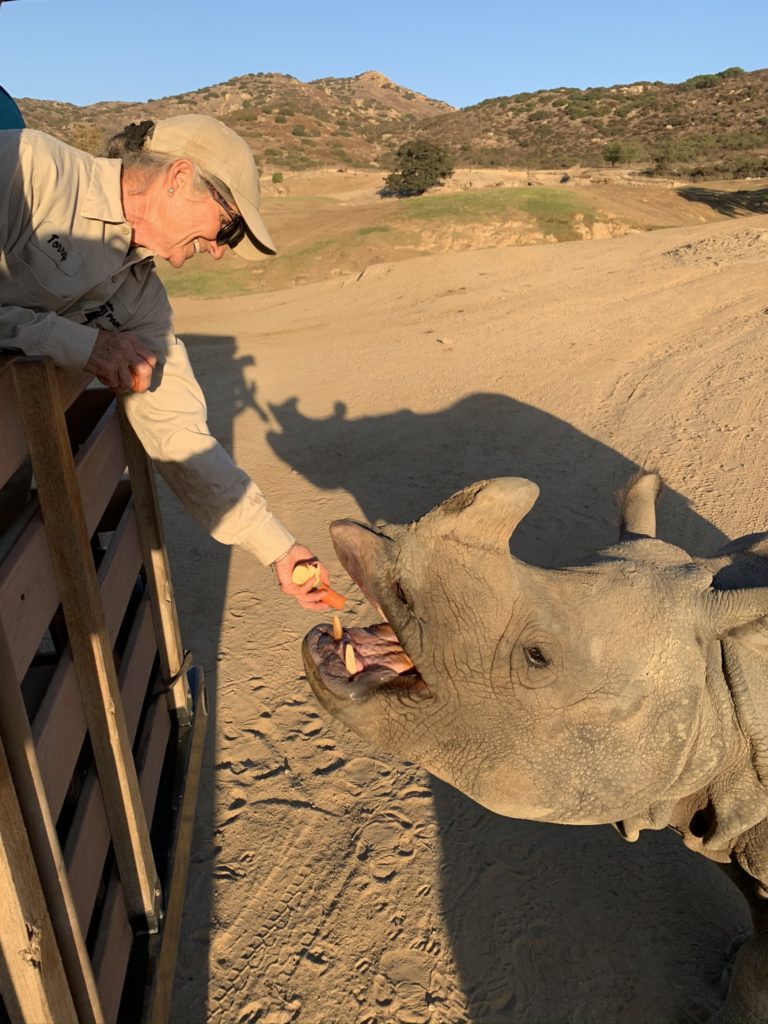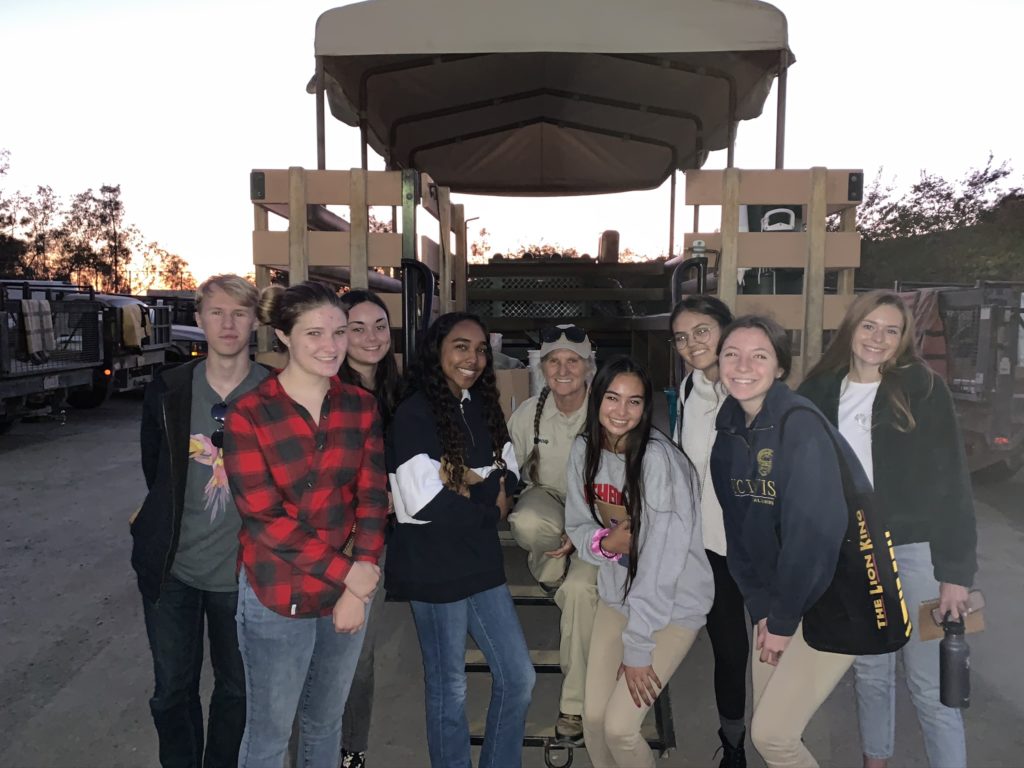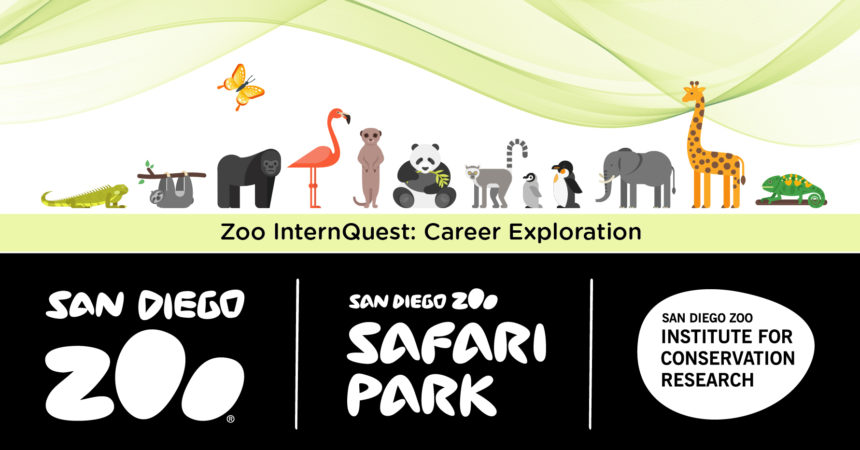Zoo InternQuest is a seven-week career exploration program for San Diego County high school juniors and seniors. Students have the unique opportunity to meet professionals working for the San Diego Zoo, Safari Park, and Institute for Conservation Research, learn about their jobs, and then blog about their experience online. Follow their adventures here on the Zoo’s website!

Ms. Pillsbury’s shared office space. The boards and papers on the walls have information about the animals she is responsible for. This includes details about their diet, medical needs, and even if they are due to give birth.
This week we were able to go on a safari with an amazing tour guide: Torrey Pillsbury, a Senior Mammal Keeper at the San Diego Zoo Safari Park (Park). As we toured the expansive Eastern Plains field enclosure, interacting with greater one-horned rhinos and giraffes, Ms. Pillsbury told us about her awesome career. One of the most exciting aspects of her job is that she gets to work with the Przewalski’s horses, the last remaining wild horses. Some of them have quite the sweet spot for her and enjoy getting brushed by Ms. Pillsbury. Another primary aspect of her job is to keep an eye on adorable baby animals. Ms. Pillsbury makes sure that any new babies born on exhibit have a healthy relationship with their mother, and will sometimes raise them herself at the Park’s Care Center as a last resort if the mom doesn’t have the appropriate maternal instincts. Another big part of Ms. Pillsbury’s job as a keeper is daily record keeping. All keepers diligently record all animal observations, behavioral changes, medications given, new births, and more. These records are the best way to document specific animal care needs and communicate vital information between the veterinarians and fellow coworkers. It’s quite a responsibility since Ms. Pillsbury cares for over 200 animals. Although she’s been a keeper since 1989, Ms. Pillsbury says she is frequently surprised by the animals she works with and loves the individuality and uniqueness of each one.

Ms. Pillsbury began working at the Safari Park when she was only 19 years old! Prior to working at the Park, she had begun studying animal science at California Polytechnic State University, but she cut her education short when she was offered a position she couldn’t refuse. Ms. Pillsbury also had extensive horseback riding experience, which meant she was not only comfortable around animals but she also knew how to look after them. When she first started at the Park, she performed in the horse show. When the show was canceled, she was offered a position working with elephants. In 1989 she transitioned from her position as an elephant keeper to a field exhibit keeper. Ever since, she has been one of the incredible people who run the field exhibits and care for the many animals inhabiting them. During her time as a keeper, she was also offered the chance to work at the Phoenix Zoo for six months. While there, Ms. Pillsbury worked with tropical animals such as anteaters, capybaras, and hornbills, but by far, her favorite was being able to work with the primates. Ms. Pillsbury even had the opportunity to assist in raising a baby gorilla while at the Phoenix Zoo. Ms. Pillsbury has worked as a keeper at the Safari Park for approximately 35 years and she has cherished every second of it.

Aside from the daily care the keepers give to their animals, they also play an impactful role in conservation through their ability to connect guests to the Park’s collection. Ms. Pillsbury is able to connect with the public and help spread awareness through her tours, using her passion for animals to inspire others to get involved. Keepers also help by managing the populations of species through breeding and reintroduction efforts. Another big part of conservation that goes unnoticed includes being well informed about every single species. As a keeper, Ms. Pillsbury is able to study the animals up close and collect information that can assist with their wild counterparts. Other keepers also get opportunities to help outside the Park with conservation projects. Many do this by taking trips to local habitats to collect data and participate in population counts, such as with the bighorn sheep here in southern California. If you are interested in conservation, Ms. Pillsbury recommends getting involved with the San Diego Zoo Global and its Institute for Conservation Research. The organization has plenty of volunteer and research opportunities available for anyone willing and passionate about the cause.

One of the many endangered species Ms. Pillsbury has worked with during her time at the Park is the Arabian oryx. This species, indigenous to the Middle East, became extinct in the wild in the late 1960s due to anthropogenic activities. It is a cultural tradition for members of high-status families to hunt the Arabian oryx, but the development of automatic weapons with lethal accuracy made it extremely easy to over-hunt oryx. In addition to them being hunted, they were also threatened by the civil unrest that was present around their habitat. Fortunately, the Park was one of the facilities that was able to take in some of the few remaining individuals and participate in a breeding program as part of Operation Oryx. The efforts to save the Arabian oryx has resulted in almost 400 individuals being born at the Safari Park. Once the numbers stabilized, the oryx was reintroduced to the wild in Oman, Israel, Syria, and Saudi Arabia. The Arabian oryx is one of the first species to be successfully reintroduced to the wild after having undergone human intervention and breeding programs. Now, there are a few individuals remaining in San Diego that call the Safari Park their home.

Working as a keeper and taking care of these amazing animals requires the ability to think fast on your feet, be observant, diligent, a good communicator, and most of all, good at raking! Working with a wide variety of species from rhinos to orangutans, she’s had the opportunity to learn about, and work up close with some amazing animals. Although she doesn’t have a formal collegiate education in biology or animal science, Ms. Pillsbury has acquired all the skills needed to keep the Park’s animals happy and healthy. She’s learned most aspects of her job through experience, and thoroughly believes that, “the most rewarding part of working as a keeper is that you never stop learning”. Ms. Pillsbury told us you can never be an expert on all species, because every day on the job brings more knowledge and understanding of the animals you work with. For her, there’s no such thing as a boring day. If you have a passion for education, conservation, and love to spend time outdoors with stunning wildlife, being a keeper might just be the career for you!

Ms. Pillsbury adores her job, but like most people around the world, she despises early morning traffic. However, working with animals makes the 4:00 a.m. wakeup call worth it. Her favorite aspect of the job is that it she never stops learning. Despite her immense love for hoofstock, she believes it is a mistake to only concentrate on just one type of animal. Her favorite experience throughout her career, was raising a baby gorilla. This was her first time experiencing motherhood, which meant learning how to bottle feed and burp a baby. Babies require round the clock care, which meant spending long nights with the baby gorilla Amali. Amali went on to have her own baby and raise it herself, which is remarkable since animals that are hand-reared as babies can have a harder time taking care of their own offspring. Still, she says that the best thing about working with gorillas in neonatal care, is that they love to hang onto people, meaning that she could walk around with one of them hugging her neck.

From the beginning to the end of our safari, we heard countless stories and acquired a wealth of information about Ms. Pillsbury and her career. Lucky enough to have connections, Ms. Pillsbury had a surprisingly smooth journey to becoming a senior mammal keeper. Not having a formal college education, her background in horseback riding was the only thing that she needed in order to jump start her career path. Her familiarity in working with larger animals (such as horses) comfortably led her to becoming an elephant keeper and then to her current position as a senior mammal keeper. Being a tour guide of the plains as well, she is equipped with skills such as an upbeat and extroverted personality. Ms. Pillsbury’s ever growing skill-set and her many characteristics are what make her perfect for her job.

The interns with Ms. Pillsbury in front of the truck we used to see the plains enclosures of the San Diego Zoo Safari Park. Want to have a similar experience? You can book a Caravan Safari! https://www.sdzsafaripark.org/safari/caravan-safari
Week Six
Fall Session 2019


